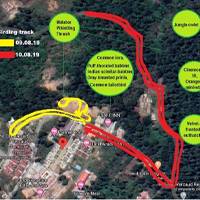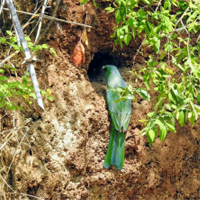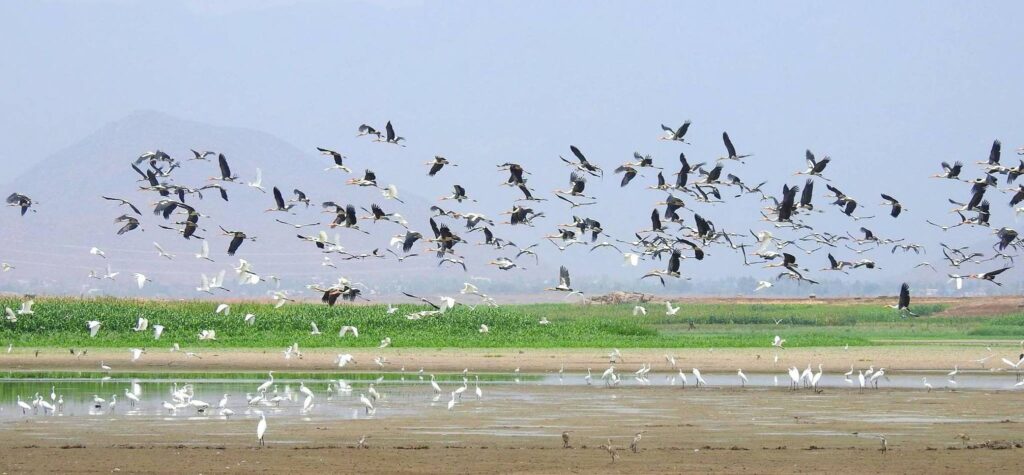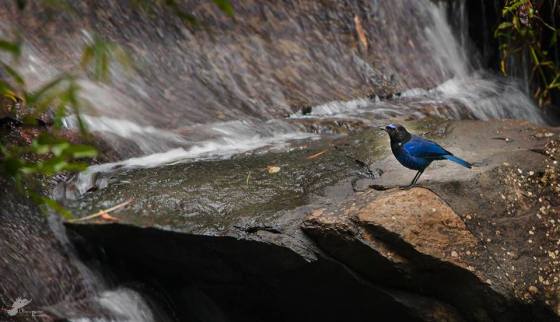The Whistling Schoolboy & his friends from Yercaud
Dr C Sreekumar, Professor & Head (Wildlife Science), Madras Veterinary College at Tamil Nadu Veterinary & Animal Sciences University.
It was a few of months back that one of the members of our ‘school group’ mooted the idea of a get-together at Yercaud between 09.08.19 and 12.08.19. The group, aptly named ‘TVS Vagupparai,’ consisted of students of T.V. Sundaram Higher Secondary School, Madurai, from 1977 to 1984. For me, this get together, (as any trip outside Chennai) was an opportunity for birding at one of the pristine birding niches in Tamil Nadu. I have heard a lot about the avifauna of Salem in general and Yercaud in particular and was keen that I spent at least a part of my stay there to look around for birds. Our group had already met on many such congregations all over Tamil Nadu and in the past two such occasions, I had started to get my school friends also into trekking and birding activities. This was going to be a tight trip for me as far as availability of time was concerned, as I was already booked to leave for Port Blair, Andamans (another stupendous birders’ paradise) on a private visit on 11th. That meant I would barely have a full day of birding at Yercaud and I was determined to make the most of it.
ARRIVAL PLEASANTRIES
We reached Hotel Aradhana Inn by 4.40 P.M. on 09.08.19, driving from Chennai. Most others had already reached and an hour was spent settling in and touching base with classmates. By around 5.45 in the evening, I suggested that we take a walk through the roads by the Inn and do some birding by the side. I geared myself up with my camera (Sony DSC HX400v, a bridge camera), binoculars (Nikon Aculon 10×50) and of course, my Yu Yureka phone (which I use for recording bird sounds as well as uploading data to eBird) and set out with my friends. Being an overcast day, the light was already failing and I knew photography would be disappointing. We started a leisurely walk through the road and could immediately spot the usual suspects. The trees around the Inn had their own populations of bulbuls. Both Red-vented Bulbuls and Red-whiskered Bulbuls were aplenty, hurriedly foraging in the fading evening. Though commoners, one can never be tired of watching these birds.

CALL OF THE CRAG-MARTIN
One of my friends pointed out to the small black birds zipping through the trees and into the compound, in and out repeatedly. Initially I thought they were swallows. But as the next one flew past, it was clear that they were Dusky Crag-Martins. There were many more out in the open ground in front of the hotel, flying low and hunting. I was excited to see that they were vocalizing as they flew past. As I had never recorded their sound, I was keen to get it on tape and set myself in a position to record the call of the next bird on sortie. It turned out that while their chirps were clearly audible, it was another thing to catch it clean on tape. If places like Chennai have problems with extraneous sounds by vehicles, places like Yercaud have their own problems, with the persistent sounds of nature getting in the way of a good audio recording. If it isn’t the wind, it could be the cacophony of other louder birds! I did manage to capture a few chirps from the crag martins, just loud enough to be processed. To listen to the recorded call, please click here.

A mixed flock consisting of both Common and Jungle Mynas were seen in the adjacent plots. A couple of the Jungle Mynas were alternatively calling and I managed to get them on tape. The walk down the road was not too rewarding, barring the ever-present background music by White-cheeked Barbets. Back near the inn, we could listen to the typical, nasal call of Ashy Woodswallows. They were probably riding the thermals high above or were just across the horizon and calling. Try as hard as we all might, we still couldn’t locate them.

By then, it was almost dark and as I was about to call off the walk, when I saw a black bird with a fairly long tail hopping on a rock in the farthest left corner of the open ground. Momentarily, I thought it was a male Indian Robin. But then realization struck that it was a Malabar Whistling-Thrush! I was excited, for though I recorded their songs earlier, this was the first time I am seeing this exceedingly talented musician in person! I hastily informed others as to what the bird was and tried to keep pace with it, which was almost scurrying ‘babbler-like’ into the wooded areas. Soon it was out of sight. Poor light hampered a photo documentation, but then I was elated. I explained to others what a great singer the bird was and we all waited a while fondly looking in the direction expecting the bird to sing. Nothing happened.
Returning to the Inn, I heard the typical roosting call, repeated sets of a fairly high pitched ‘ktrrrrrrrr,’ of an Oriental Magpie-Robin. A brief search and there he was hopping, on the lowest branches of bottle-brush tree and recorded his call with almost good clarity. During the night I processed the audio files and was pleasantly surprised to find that the Malabar Whistling-Thrush had indeed called after disappearing into the thicket, with two faint but distinct notes of its call and song appearing in the sonogram of the Oriental Magpie-Robin. Now that I had seen the flautist in the vicinity, and even caught it on tape, I was hoping for a melodious musical rendition to wake me up in the morning.

SIGHTINGS FROM THE SECOND DAY
The next morning (10.08.2019) I was a tad disappointed that the Malabar Whistling-Thrush had not cared to entertain me with a melodious wake up call. All my friends who had earnestly promised to tag along with me had also let me down. So I started off alone. As soon as I stepped into the patio, I was greeted by the song of a Red-whiskered Bulbul, or rather two of them in a match. As the ambience was good, I took time recording their songs which were occasionally interrupted by Common Mynas and Large-billed Crows. I set off in the road in the opposite direction to where I walked yesterday and soon enough the Ashy Woodswallows, which I missed yesterday, were there bunching into the tight groups that they are usually seen in, only that this time they were atop a barren tree rather than the powerlines that they prefer.

A little more down the road where a stream was crossing, there was a virtual cacophony of birds, all of them trying to out-sing the other. With the stream providing a steady background, I could only make out that there were White-cheeked Barbets, Oriental Magpie-Robins, Common Ioras, Puff-throated Babblers, Grey-breasted Prinias, Indian Scimitar-Babblers, Asian Koels and White-throated Kingfishers.

I spent some time at the spot, trying my luck with the recording and could actually get bits of calls of Common Iora and Puff-throated Babbler on tape. I was also fortunate that during the wait, a Black-rumped Flameback whizzed by, adding to the din with its characteristic call. As I walked along, leaving behind the buildings and venturing into the wooded areas, the trees were full of birds, mostly mixed flocks of mynas and numerous Velvet-fronted Nuthatches. The nuthatches were really loud and creating a ruckus at the crown of a barren tree but I could neither get a decent shot nor a clean recording of their vocalization.

As I passed a stream, an ashy-grey bird flew across the road onto a huge tree and I saw that it was a Cinereous Tit, exploring the crevices of the tree barks. The fidgety bird flew away soon, denying me an opportunity for a decent photograph. Further down the road, I found the Spotted Doves and Greater Coucal but was starting to get disappointed in not finding the Malabar Whistling-Thrushes. I decided to turn back and then I heard the ‘croo, crooo croooo, cruck, cruck” of a Jungle Owlet from somewhere deep inside the jungle, too faint to be recorded. I trudged back, passing a few Oriental Magpie-Robins and White-cheeked Barbets. A beautiful pair of Orange Minivets appeared from nowhere and briefly hung around the branches of a tree before flying away. A random scan of the tree-line got me a resplendent Plum-headed Parakeet which posed long enough for snap. Then, I heard the shrill whistle of a Malabar Whistling-Thrush from quite nearby to the right. I could make out that there were actually two calls in succession. Within minutes both birds, in some kind of a courtship display, were chasing around in the trees by the road. They were both calling in duet and flying after each other in the trees, providing me ample opportunity to photograph and record them.

On the way back, I met another Malabar Whistling-Thrush, who was generous to entertain me with a ‘sound and light show’, which I recorded (https://youtu.be/lAchuLJYKt8). The sun, by then was really up and the programmes for the get-together slated to start soon. As I was hurrying down, I saw an Oriental Honey-buzzard, with a couple of Large-billed Crows in hot pursuit, glide into the horizon and disappear.
On the whole it was entertaining birding (https://ebird.org/india/checklist/S58871262 and https://ebird.org/india/checklist/S58856122 )and I wish to be back with more time on my hands to bird at this beautiful location. Hopefully, some other day!
The Whistling Schoolboy & his friends from Yercaud Read More »




















